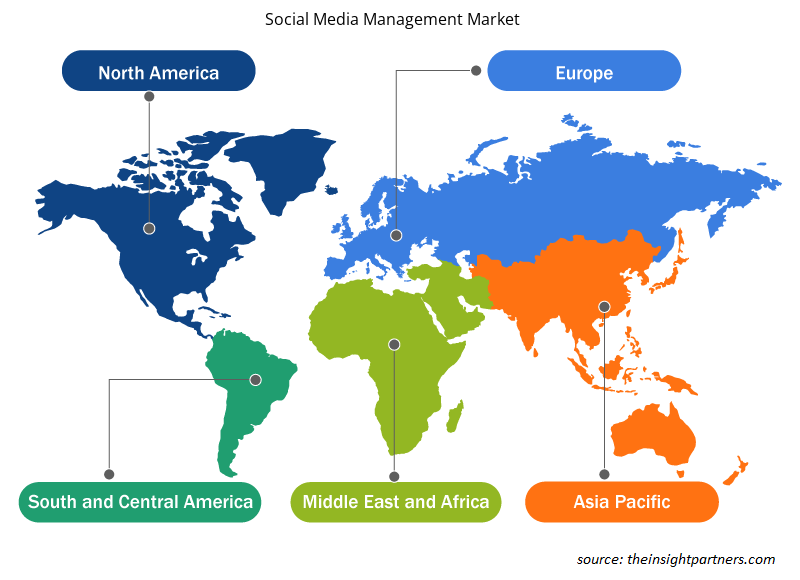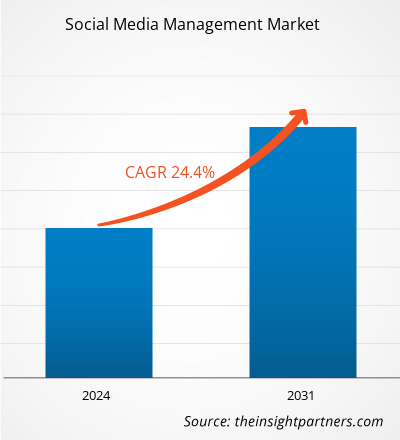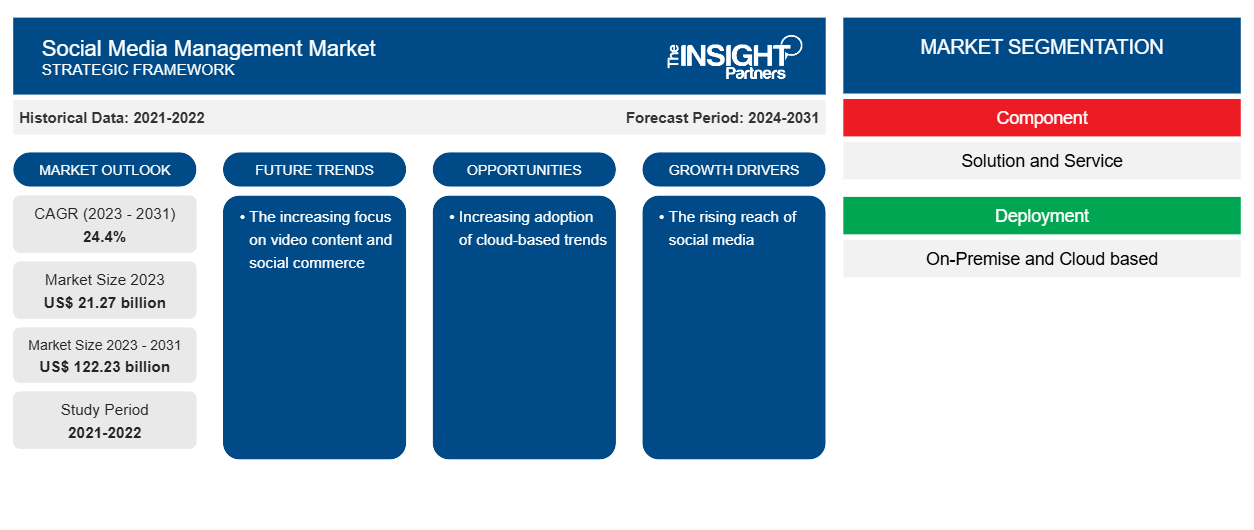Si prevede che la dimensione del mercato della gestione dei social media raggiungerà i 122,23 miliardi di dollari entro il 2031, rispetto ai 21,27 miliardi di dollari del 2023. Si prevede che il mercato registrerà un CAGR del 24,4% nel periodo 2023-2031. È probabile che la crescente attenzione ai contenuti video e al commercio sui social rimanga una tendenza chiave nel mercato.
Analisi di mercato della gestione dei social media
Le piccole e medie imprese (PMI) stanno adottando sempre più la gestione dei social media a causa del crescente numero di PMI e dello spostamento dell'attenzione sul marketing online, come il marketing sui social media. Interagire con le persone sui social media è un'importante strategia di marketing per le piccole imprese. Utilizzare i social media aiuta un'azienda ad aumentare la consapevolezza del proprio marchio, ad aumentare la base di clienti dell'azienda e a interagire con i clienti attuali. È facile per i titolari di piccole imprese impegnarsi nel marketing tramite i social media, a patto che l'azienda pubblichi sulle pagine dei social media, ed è un approccio di marketing conveniente. Facebook, Instagram, Twitter, LinkedIn e Pinterest sono tutte piattaforme di social media popolari.
Panoramica del mercato della gestione dei social media
La gestione dei social media è un processo che implica la pianificazione della pubblicazione, la creazione di contenuti, l'interazione con gli utenti, lo sviluppo di una strategia, il monitoraggio delle prestazioni e l'aumento della visibilità degli account di un'azienda sui social media . Ti facilita nell'instaurare relazioni con gli abbonati e pubblicare post pertinenti. La gestione dei social media è un catalizzatore per un risultato aziendale positivo. Una forte presenza sui social media aumenta la consapevolezza di un marchio, promuove il servizio clienti ed estende la sua portata a nuovi pubblici. Le collaborazioni con gli influencer possono fornire connessioni durature con il pubblico. Immagini e testi creativi possono alterare la percezione degli individui in un'organizzazione.
Personalizza questo report in base alle tue esigenze
Riceverai la personalizzazione gratuita di qualsiasi report, comprese parti di questo report, o analisi a livello nazionale, pacchetto dati Excel, oltre a usufruire di grandi offerte e sconti per start-up e università
-
Scopri le principali tendenze di mercato in questo rapporto.Questo campione GRATUITO includerà analisi di dati che spaziano dalle tendenze di mercato alle stime e alle previsioni.
Approfondimenti regionali sul mercato della gestione dei social media
Le tendenze regionali e i fattori che influenzano il mercato della gestione dei social media durante il periodo di previsione sono stati ampiamente spiegati dagli analisti di Insight Partners. Questa sezione discute anche i segmenti e la geografia del mercato della gestione dei social media in Nord America, Europa, Asia Pacifico, Medio Oriente e Africa e America meridionale e centrale.

- Ottieni i dati specifici regionali per il mercato della gestione dei social media
Ambito del rapporto di mercato sulla gestione dei social media
| Attributo del report | Dettagli |
|---|---|
| Dimensioni del mercato nel 2023 | 21,27 miliardi di dollari USA |
| Dimensioni del mercato entro il 2031 | 122,23 miliardi di dollari USA |
| CAGR globale (2023-2031)CAGR (2023 - 2031) | 24,4% |
| Dati storici | 2021-2022 |
| Periodo di previsione | 2024-2031 |
| Segmenti coperti |
Per componente
|
| Regioni e Paesi coperti |
America del Nord
|
| Leader di mercato e profili aziendali chiave |
|
Densità degli attori del mercato: comprendere il suo impatto sulle dinamiche aziendali
Il mercato del Social Media Management Market sta crescendo rapidamente, spinto dalla crescente domanda degli utenti finali dovuta a fattori quali l'evoluzione delle preferenze dei consumatori, i progressi tecnologici e una maggiore consapevolezza dei vantaggi del prodotto. Con l'aumento della domanda, le aziende stanno ampliando le loro offerte, innovando per soddisfare le esigenze dei consumatori e capitalizzando sulle tendenze emergenti, il che alimenta ulteriormente la crescita del mercato.
La densità degli operatori di mercato si riferisce alla distribuzione di aziende o società che operano in un particolare mercato o settore. Indica quanti concorrenti (operatori di mercato) sono presenti in un dato spazio di mercato in relazione alle sue dimensioni o al valore di mercato totale.
Le principali aziende che operano nel mercato della gestione dei social media sono:
- Adobe
- Società IBM
- Google LLC
- Società Oracle
- Salesforce.com Inc.
- HubSpot Inc.
Disclaimer : le aziende elencate sopra non sono classificate secondo un ordine particolare.

- Ottieni una panoramica dei principali attori del mercato della gestione dei social media
Notizie di mercato e sviluppi recenti sulla gestione dei social media
Il mercato della gestione dei social media viene valutato raccogliendo dati qualitativi e quantitativi dopo la ricerca primaria e secondaria, che include importanti pubblicazioni aziendali, dati associativi e database. Di seguito sono elencati alcuni degli sviluppi nel mercato della gestione dei social media:
- Nell'ambito della promozione della sua nuova suite di creazione Adobe Express, Adobe ha stretto una partnership con Meta per lanciare un nuovo programma di formazione "Express Your Brand", progettato per aiutare i titolari di piccole imprese a creare contenuti più efficaci e strategie di marketing digitale e a massimizzare il loro business. (Fonte: Adobe, comunicato stampa, maggio 2022.)
- Social Guru USA ha annunciato il lancio del suo sito web appena rinnovato, che offre servizi completi di gestione dei social media. Questo sviluppo segna una pietra miliare significativa dopo l'acquisizione dell'azienda. (Fonte: Social Guru USA, comunicato stampa, giugno 2024)
Copertura e risultati del rapporto di mercato sulla gestione dei social media
Il rapporto "Dimensioni e previsioni del mercato della gestione dei social media (2021-2031)" fornisce un'analisi dettagliata del mercato che copre le seguenti aree:
- Dimensioni e previsioni del mercato della gestione dei social media a livello globale, regionale e nazionale per tutti i segmenti di mercato chiave coperti dall'ambito
- Tendenze del mercato della gestione dei social media e dinamiche di mercato come driver, limitazioni e opportunità chiave
- Analisi dettagliata delle cinque forze PEST/Porter e SWOT
- analisi di mercato della gestione dei social media che copre le principali tendenze del mercato, il quadro globale e regionale, i principali attori, le normative e i recenti sviluppi del mercato
- Analisi del panorama industriale e della concorrenza che copre la concentrazione del mercato, l'analisi della mappa di calore, i principali attori e gli sviluppi recenti per il mercato della gestione dei social media
- Profili aziendali dettagliati
- Analisi storica (2 anni), anno base, previsione (7 anni) con CAGR
- Analisi PEST e SWOT
- Valore/volume delle dimensioni del mercato - Globale, Regionale, Nazionale
- Industria e panorama competitivo
- Set di dati Excel
Report recenti
Rapporti correlati
Testimonianze
Motivo dell'acquisto
- Processo decisionale informato
- Comprensione delle dinamiche di mercato
- Analisi competitiva
- Analisi dei clienti
- Previsioni di mercato
- Mitigazione del rischio
- Pianificazione strategica
- Giustificazione degli investimenti
- Identificazione dei mercati emergenti
- Miglioramento delle strategie di marketing
- Aumento dell'efficienza operativa
- Allineamento alle tendenze normative























 Ottieni un campione gratuito per - Mercato della gestione dei social media
Ottieni un campione gratuito per - Mercato della gestione dei social media